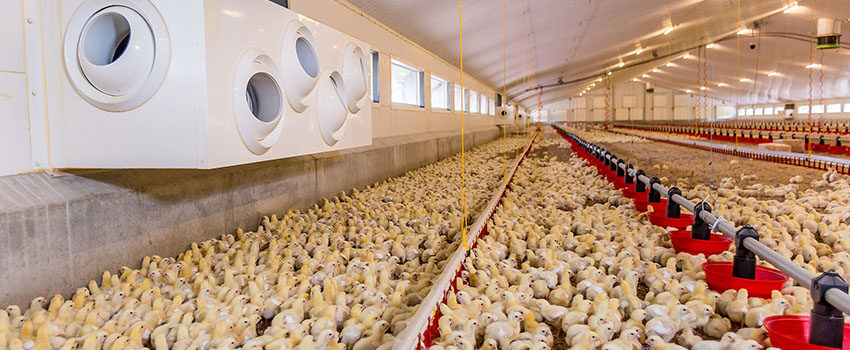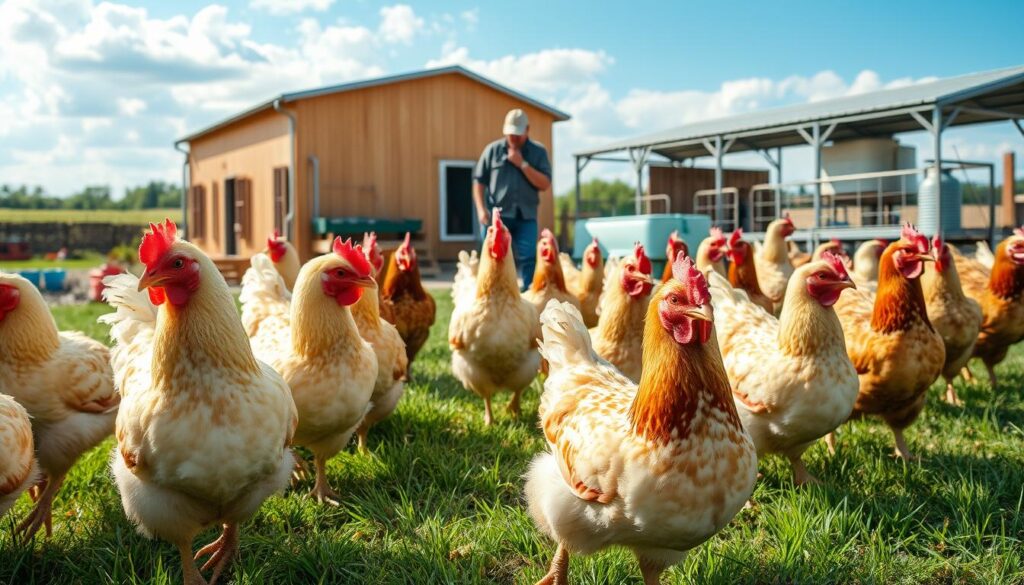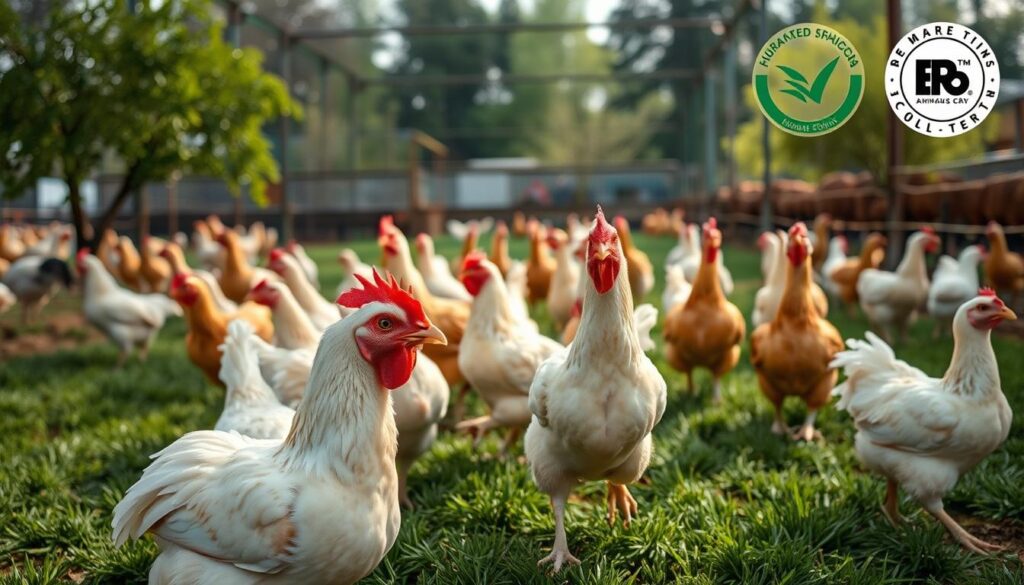
The global poultry industry is facing a big challenge. It’s about managing the fast growth of broiler chickens. About 70 percent of chickens raised for meat worldwide are in intensive farming systems. This includes almost all chickens in the United States, United Kingdom, and Europe, and more in developing countries.
These systems often cause pain and distress in broiler chickens. They grow too fast in crowded, dirty sheds without fresh air or sunlight. This leads to health and welfare issues that affect their growth.
Key Takeaways
- Approximately 70% of broiler chickens globally are raised in intensive farming systems with limited space and access to the outdoors.
- Broiler chickens today reach slaughter weight in just 47 days, compared to 70 days in the 1950s, leading to health and welfare concerns.
- Monitoring broiler growth, feed consumption, and flock uniformity is crucial for identifying and addressing any issues affecting their development.
- Implementing strategies to optimize broiler nutrition, environmental management, and genetic selection can help promote healthy growth and weight gain.
- Industry shifts towards alternative chicken breeds and improved farming practices aim to reduce the suffering of broiler chickens.
Intensive Broiler Chicken Farming Practices
Overcrowded and Confined Living Conditions
In the United States, broiler chicken sheds are often cramped and dark. They lack natural light and are covered in litter. This litter is only fully cleaned out every few years.
This creates a dirty environment for the birds. It can cause painful lesions, infections, and breathing problems. The litter is made from the droppings of thousands of chickens.
The air inside these sheds is also a big problem. Ammonia from the droppings can hurt the birds’ eyes and lungs. Broiler chickens in these conditions can’t adjust to heat, cold, or aggression from other birds.
“Chickens confined in these barren sheds are not able to make adjustments within their environment to avoid heat, cold, or other birds as they would do in natural conditions.”
The harsh conditions in broiler chicken housing harm their health and welfare. It can lead to physical and behavioral problems. Changing intensive poultry farming practices is key to improving their lives and the industry’s future.
Rapid Growth and Fast Weight Gain
Today’s broiler chickens grow much faster than their ancestors. They reach slaughter weight in just 47 days. This is a big jump from the 70 days it took in the 1950s to weigh less than 3 lbs.
Their fast growth is due to genetic selection for more white meat. Unlike traditional breeds that lived up to eight years, today’s chickens grow large breasts quickly. They can weigh up to 6.5 lbs by slaughter time.
This fast growth has changed the poultry industry. It makes production more efficient and profitable. But, it also raises health and welfare concerns that need attention.
Addressing Growth Challenges
- Improved feed efficiency is crucial for boosting nutrient delivery and balancing energy and amino acid intake.
- Providing organic, soy-free broiler grower pellets can contribute to faster weight gain.
- Regular interaction with chickens and prompt attention to health concerns can create a conducive environment for healthy growth.
- Ensuring wellness through proper nutrition, preventative care, and minimizing feed wastage can lead to swift development.
| Key Strategies for Rapid Broiler Growth | Potential Benefits |
|---|---|
| Increasing feeder space to reduce competition and stress | Promotes healthier development during starter and grower phases |
| Grouping broilers based on body size to eliminate inequality | Reduces stress levels and supports uniform growth |
| Providing nutrient-rich feeds with essential proteins, vitamins, and minerals | Vital for fast, healthy growth in broiler chickens |
| Utilizing ‘feed-ad-libitum’ approach to maximize growth rates | Prevents weight loss and supports continuous nourishment |
Poultry farmers can improve growth rates by focusing on key factors. This ensures healthy growth and well-being in broiler chickens.
“Rapid growth and fast weight gain in broiler chickens have been a significant driver of industry advancements, but it has also introduced complex health and welfare challenges that require careful management.”
How to Identify and Address Growth Issues in Broiler Chickens
Monitoring Bird Health and Development
It’s vital to spot and fix growth problems in broiler chickens for their health and productivity. Watching their health and growth closely is key. Fast growth can harm their bodies, causing leg pain, heart and lung issues, and even death.
To tackle growth issues, it’s important to check the chickens’ mobility and leg health. Seeing how they move and stand can show if they have leg problems. Also, checking their body condition helps spot any weight or physical changes.
By keeping a close eye on the chickens’ health, farmers can find and fix growth problems early. This helps keep the birds healthy, boosts production, and supports the broiler industry’s future.
| Monitoring Aspect | Potential Growth-Related Issues | Recommended Actions |
|---|---|---|
| Mobility and Leg Condition | Painful lameness, difficulty walking, and leg deformities | Evaluate leg strength and conformation, provide pain relief if needed, and consider adjustments to housing and management practices |
| Body Condition | Rapid weight gain, heart and lung strain, and increased risk of premature death | Monitor weight gain, adjust feeding and environmental management to support healthy growth, and closely observe for any signs of health issues |

“Closely monitoring the health and development of broiler chickens, including their mobility, leg condition, and overall body condition, is crucial for identifying and addressing any growth-related issues.”
Nutritional Strategies for Optimal Growth
Creating the right nutritional plans is key for broiler chickens’ growth. Feed restriction can cause hunger and frustration, leading to bad behaviors. By making feed that supports growth without too much weight, we can solve these problems.
Recent studies show the importance of certain nutrients for broiler chickens. For example, a study on meat trends in the USA shows a shift in what people want. This means we need to focus on better weight gain and feed use. Also, research links meat consumption to a country’s economy, showing the value of efficient broiler farming.
| Nutritional Strategy | Potential Benefits |
|---|---|
| Balanced energy and protein levels | Supports healthy growth without excessive weight gain |
| Inclusion of essential amino acids | Enhances muscle development and feed conversion efficiency |
| Supplementation with vitamins and minerals | Promotes overall health and immune function |
| Use of alternative protein sources | Diversifies nutrient profiles and reduces reliance on costly ingredients |
By using these nutritional strategies, we can help broilers grow better. This improves how much feed they use and tackles issues from fast weight gain. Keeping up with research and new ideas in nutrition is vital for the broiler industry’s future.
“Proper nutrition is the foundation for optimal growth and performance in broiler chickens. By tailoring feed formulations to support healthy development, we can unlock the full potential of these birds while ensuring their welfare.”
Environmental Management for Heat Stress Mitigation
Keeping broiler chickens comfortable is key to their health and work. Sheds can get very hot, especially in warm months. If ventilation fails, thousands of birds can die in hours. Farmers use many ways to fight heat stress, like changing diets and improving ventilation.
The ideal temperature for most birds is between 60 and 75°F. Heat stress starts at 85°F, causing birds to eat less and produce less. If it gets too hot, birds can die unless they get relief. High humidity can also make older turkeys sick at lower temperatures.
Good ventilation is essential to remove heat from sheds. If barns don’t have enough vents, they can get too hot. Taking away feed before it gets hottest can also help prevent heat stress.
Nutritional Strategies for Heat Stress Mitigation
Farmers also use food to help birds handle heat. Adding electrolytes like potassium chloride to water can help. Vitamins A, D, E, and B complex in water can also reduce heat stress. Vitamin C is especially good for egg production and sperm quality.
Additional Management Practices
- Delaying barn activities during the hottest parts of the day to minimize disturbance and heat generation.
- Providing shade for pastured poultry to reduce sun exposure.
- Limiting sun exposure in the barn by using reflective materials or curtains.
By using a mix of environmental, nutritional, and management strategies, farmers can keep broiler chickens healthy and productive. This ensures the well-being of their flocks in hot weather.
| Heat Stress Mitigation Strategies | Key Considerations |
|---|---|
| Environmental Management |
|
| Nutritional Strategies |
|
| Management Practices |
|
“Effective environmental management is the key to mitigating heat stress and ensuring the welfare of broiler chickens in hot climates.”
Alternative Chicken Breeds and Genetic Strains
The poultry industry faces challenges with fast-growing broiler chickens. Researchers at the University of Guelph in Canada are looking into new breeds. They found 16 genetic strains that grow slower but are healthier and more active.
These new breeds are different from the usual fast-growing chickens. They can stand, walk, climb, and move around better. This is a big change from the fast-growing chickens that often have health problems.
The Global Animal Partnership (G.A.P.) is supporting this change. They will only allow certain chicken strains in their farm auditing program. This means over 200 companies in the U.S., like Chipotle and Popeyes, will have to use these healthier chickens.
This move towards healthier chickens is a big step. It helps the poultry industry grow in a more sustainable and ethical way. It benefits both the chickens and the people who eat them.
“These birds don’t just sit and eat, but in the study, they stood and walked more, could climb over a short barrier and traversed ramps onto platforms used in the trial to test the birds’ mobility.”
Addressing Growth Issues Through Improved Management
Optimizing Stocking Density and Flock Monitoring
In intensive broiler chicken farming, managing growth issues is key. A single shed can hold tens of thousands of birds. Each chicken gets a bit more space than an iPad, but it’s still crowded.
This overcrowding causes welfare problems. Birds can’t exercise, are disturbed, and may get scratched. As they grow, reaching food and water becomes harder, especially for lame birds.
To tackle these issues, optimizing broiler stocking density and monitoring broiler chicken flocks are vital. Managing the number of birds per square foot ensures they have enough space. Regular health checks help spot and fix problems early.
- Adequate downtime of at least 14 days between flock placements is recommended to reduce disease transmission.
- Drinking water accounts for 70–80 percent of the bird’s daily drinking needs, and an abundance of clean water reduces challenges and maximizes bird performance.
- Lowering stocking density throughout the production of birds may help reduce stress and improve performance.
- Good feed management, including access to feed and quality control to avoid contaminants like mycotoxins, is crucial for bird performance.
- Monitoring barn environment components like temperature, relative humidity, ventilation, and lighting is important for effective environmental management.
- Daily monitoring of temperature, humidity, ventilation, feed, and water consumption is recommended for understanding flock progress and early disease detection.
By using these broiler chicken management practices, farms can improve broiler chicken welfare and optimize broiler stocking density. This helps solve growth issues in intensive systems. Regular monitoring of broiler chicken flocks ensures the birds develop well and stay healthy.
Economic Considerations and Industry Shifts
The broiler chicken industry is complex and always changing. Feed costs a lot, being the biggest expense for farmers. With over 72 billion chickens raised each year, the industry is massive. Yet, there are signs of change that could help these birds.
Big companies have promised to use better chicken breeds by 2024 or 2026. This could change the industry in big ways. As more people want chicken raised better, the industry must adapt to be more ethical and green.
The changes will affect the industry’s economics a lot. In 2021, the U.S. broiler industry made over $31 billion. It also created over one million jobs, making up 20% of the world’s chicken. Switching to new breeds or genetic strains will change production costs and the industry’s overall economics.
| Key Statistic | Value |
|---|---|
| Annual Chicken Consumption per Capita (U.S.) | 45 kg (100 lbs) |
| U.S. Broiler Industry Production (2021) | 27 billion kg (59 billion lbs) |
| U.S. Broiler Industry Value (2021) | Over $31 billion |
| Broilers Weighing Less Than 4.25 lbs | Roughly 18% of Broiler Population |
| Broilers Weighing More Than 7.75 lbs | About 26% of Broiler Population |
| U.S. Broiler Industry Jobs | Over 1 million |
| U.S. Share of Global Chicken Production | Over 20% |
The broiler chicken industry is facing big changes. Animal welfare, sustainability, and what consumers want will keep shaping this fast-changing sector.
The Role of Regulations and Certifications
The broiler chicken industry is facing growth issues. Regulations and certifications are key to making positive changes. The Global Animal Partnership (G.A.P.) is leading this effort, promoting animal welfare standards.
G.A.P. sets standards for farm animal welfare certification. Producers who meet these standards can use the “Animal Welfare Certified” label. Major retailers like Whole Foods support this by featuring G.A.P. certification in their stores.
G.A.P. now requires the use of certain broiler chicken breeds. These breeds must pass welfare trials and be retested in four years to keep their certification. This change will force producers to update their practices to meet new standards.
| Key Regulatory Highlights | Impact on the Industry |
|---|---|
|
|
Regulations and certifications are changing the broiler chicken industry. Producers are working to meet broiler chicken welfare regulations and animal welfare certifications. This shift is leading to better broiler chicken production standards and significant industry changes driven by regulations.

“Maintaining high standards of animal welfare is not only the right thing to do, but it also benefits the industry as a whole by improving productivity and meeting consumer demand for ethically sourced products.”
The way broiler chickens are farmed often causes them a lot of pain. They face leg problems, breathing issues, and heart troubles. To fix this, we need to watch their health closely and make their living conditions better.
We should also look into using healthier chicken breeds. This change is already happening thanks to the industry’s efforts and new rules. People are willing to pay more for chicken that’s raised better, showing they care about animal welfare.
As the industry grows, focusing on the well-being of broiler chickens is key. This will help make our food system more humane and responsible. By working together, we can make a better future for these animals and for us.